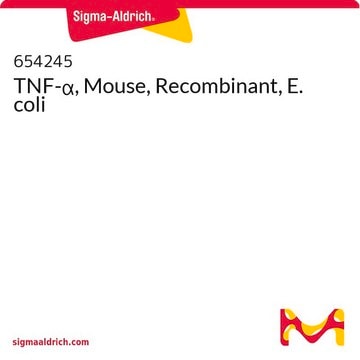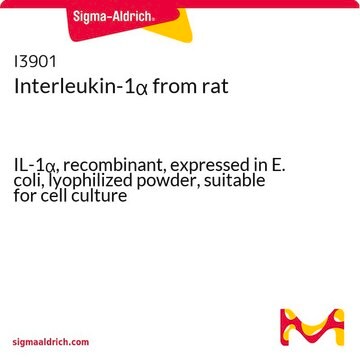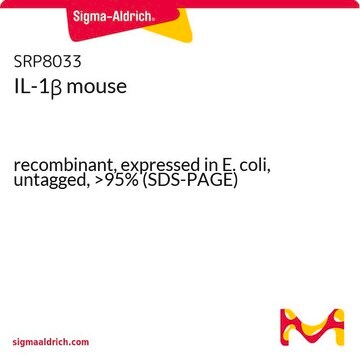T7539
Tumor Necrosis Factor-α from mouse
TNF-α, recombinant, expressed in E. coli, powder, suitable for cell culture
Sinónimos:
mTNF-α, TNF-α
About This Item
Productos recomendados
origen biológico
mouse
Nivel de calidad
recombinante
expressed in E. coli
Análisis
≥95%
formulario
powder
potencia
0.01-0.5 ng/mL EC50
mol peso
17 kDa
envase
pkg of 10 μg
pkg of 50 μg
condiciones de almacenamiento
avoid repeated freeze/thaw cycles
técnicas
cell culture | mammalian: suitable
impurezas
≤1 EU/μg protein endotoxin
color
white
solubilidad
water: soluble
Nº de acceso UniProt
temp. de almacenamiento
−20°C
Información sobre el gen
mouse ... Tnf(21926)
Categorías relacionadas
Aplicación
- to activate MS1 endothelium cells
- to induce lipolysis in adipocytes
- to study its effect on liganded and unliganded glucocorticoid receptor (GR) in interleukin (IL)-6 and IL-8 gene regulation
Acciones bioquímicas o fisiológicas
Definición de unidad
Forma física
Palabra de señalización
Warning
Frases de peligro
Consejos de prudencia
Clasificaciones de peligro
Eye Irrit. 2 - Skin Irrit. 2
Código de clase de almacenamiento
11 - Combustible Solids
Clase de riesgo para el agua (WGK)
WGK 3
Punto de inflamabilidad (°F)
Not applicable
Punto de inflamabilidad (°C)
Not applicable
Equipo de protección personal
Eyeshields, Gloves, type N95 (US)
Certificados de análisis (COA)
Busque Certificados de análisis (COA) introduciendo el número de lote del producto. Los números de lote se encuentran en la etiqueta del producto después de las palabras «Lot» o «Batch»
¿Ya tiene este producto?
Encuentre la documentación para los productos que ha comprado recientemente en la Biblioteca de documentos.
Los clientes también vieron
Artículos
Lipid Induced Insulin Resistance
Nuestro equipo de científicos tiene experiencia en todas las áreas de investigación: Ciencias de la vida, Ciencia de los materiales, Síntesis química, Cromatografía, Analítica y muchas otras.
Póngase en contacto con el Servicio técnico









